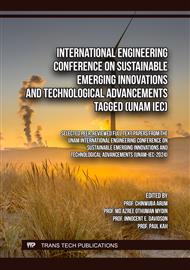p.3
p.11
p.25
p.37
p.47
p.57
p.71
p.87
Numerical Modelling of B0140 Okatana Bridge along C46 in Ongwediva
Abstract:
This paper presents findings from an ongoing study on the condition assessment and numerical modelling of a reinforced concrete bridge B0140 along C46 in Ongwediva, Namibia. An analysis of bending moments, stresses and deflections of the bridge under the prevailing abnormal loads on the bridge was undertaken using Autodesk Robot Structural Analysis Professional (RSAP) software. The aim of this study was to develop a numerical model of bridge B0140. The objectives of this study were twofold, namely, to use the developed model to predict bending moments, stresses and deflection of the bridge structural elements and to evaluate the adequacy of the existing reinforcement under the prevailing environmental conditions and abnormal loads according to BS 5400 requirements. Information pertaining to the geometry of the bridge and the mechanical properties of the materials used for construction were obtained from “as-built” engineering drawings from the Roads Authority (RA) of Namibia, physical measurements and non-destructive testing in situ. Preliminary results from the developed model indicate that the bending moments, stresses and deflections of the bridge under the prevailing environmental conditions and abnormal loads are satisfactory. The developed model, however, needs further refinement, calibration and validation to improve its accuracy.
Info:
Periodical:
Pages:
37-44
Citation:
Online since:
November 2025
Authors:
Price:
Сopyright:
© 2025 Trans Tech Publications Ltd. All Rights Reserved
Share:
Citation:


